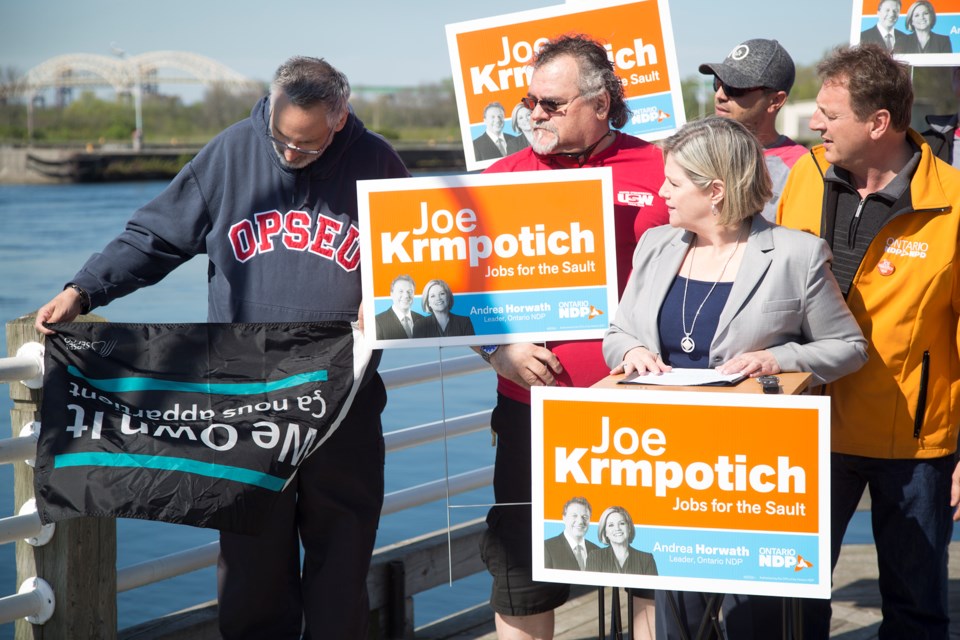The leader of the Ontario NDP says it's frustrating to see existing rail lines in northern Ontario being neglected, while the government is investing millions of dollars in studies for new rail lines in southern Ontario.
Andrea Horwath, the Ontario NDP leader, made a policy announcement regarding the Huron Central Railway (HCR) on the boardwalk in Sault Ste. Marie this morning with local byelection candidate Joe Krmpotich.
In a recent presentation to city council, a representative from Genesee & Wyoming Canada, INC. — the parent company of HCR — said the Sault to Sudbury line is currently in 'survival mode' and its profits are insufficient to cover the capital investments needed.
The company, which transported an estimated 7,400 loads of cargo for Essar Steel Algoma in 2016, is currently seeking provincial funds to address its infrastructure needs.
“The loss of the Huron Central Railway would be yet another hit to the economy in the Sault, particularly to Essar Steel Algoma’s recovery,” said Horwath.
An NDP government, said Horwath, would commit $20 million over five years to fund the province's share of the capital costs needed to keep the line running.
“Rail lines are vital to the north’s prosperity. They are the backbones of the long-established industries that drive the north and they are the building blocks of new opportunities, like the Ring of Fire,” said Horwath.
If the NDP were to win the general election on June 7, 2018, the soonest it could form a government in Ontario would be late summer 2018.
It's frustrating, said Horwath, to see the Liberal government commit $15 million toward funding an environmental assessment for a proposed $22-billion high-speed rail corridor between Toronto and Windsor, while ignoring a service in northern Ontario that she calls 'absolutely vital'.
“When (it's) something like a lifeline, that literally keeps people working here, keeps goods moving to market, there should be no question whatsoever," she said.
Between 2011 and 2015, the provincial government contributed $15 million toward infrastructure improvements for the line, with a matching contribution from the federal government.
HCR said the route was financially viable and efficient in the years it benefited from government infrastructure funding, which ended in 2015.
The company employs 44 and transported an estimated 13,600 carloads in 2016 — 54 per cent of which was transported for Essar Steel Algoma (Algoma Steel).
Krmpotich said the lack of committed funding for HCR is another way northerners are being ignored by the government.
"We need to have our infrastructure here in the north (invested) in, so we can help move and grow our economy and keep our young people here with the jobs that go with it,” said Krmpotich.
Horwath said she also sees a role for the provincial government in funding passenger rail in northern Ontario, including the Algoma Central Railway passenger service between the Sault and Hearst, which was mothballed in 2015. In 2012, funding was also cut for the Northlander service between Cochrane, North Bay and Toronto .
"There needs to be real thought put into the connectivity of northern communities — that means rail and bus. The fact that the Liberals, a couple of years ago, deep-sixed the Northlander was a huge blow. Now here we are taking about the (ACR),” said Horwath.
"We have seen a massive erosion in available transportation here, and that’s not acceptable. There has to be some investment here,” she added.
Just because northern Ontario has a lower population doesn't mean the region doesn't deserve quality public transit, she said.
"While the population is more sparse, guess what? It’s called public transportation for a reason because it needs public investment. It can’t operate for a profit because no one can make a profit on it,” said Horwath.
Virtually every transportation system around the world receives public subsidy, she said.
“And remember, rail is one of the most environmentally-sustainable ways to move goods through our economy. To lose short-line rail is not an option, that’s why government needs to be at the table to help invest in this infrastructure,” said Horwath.
